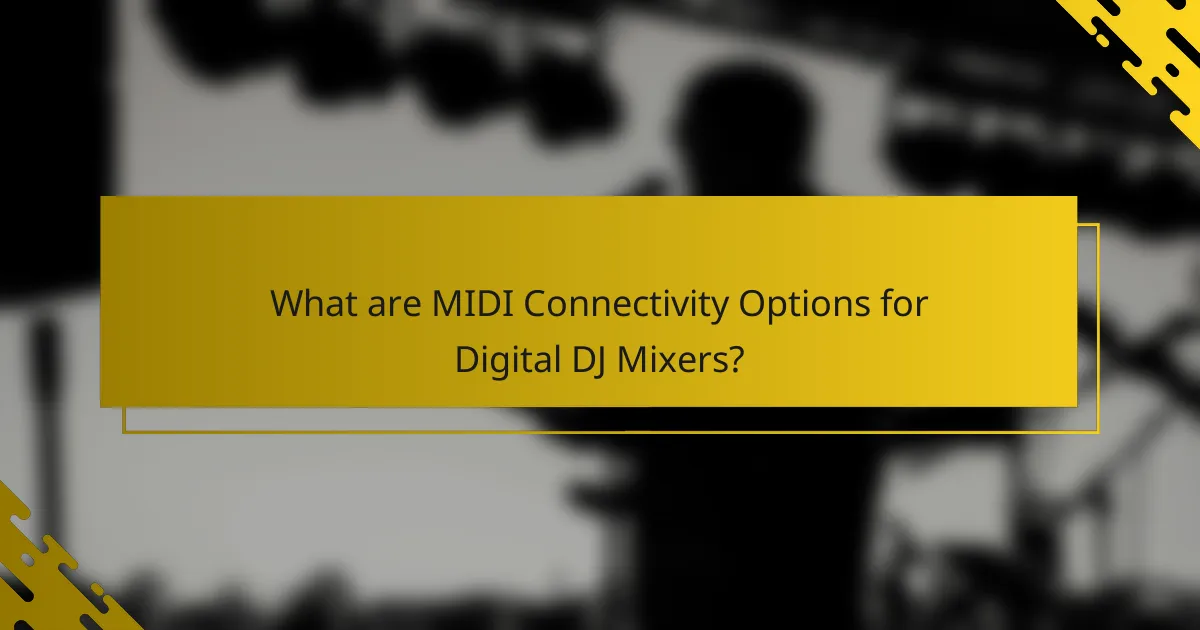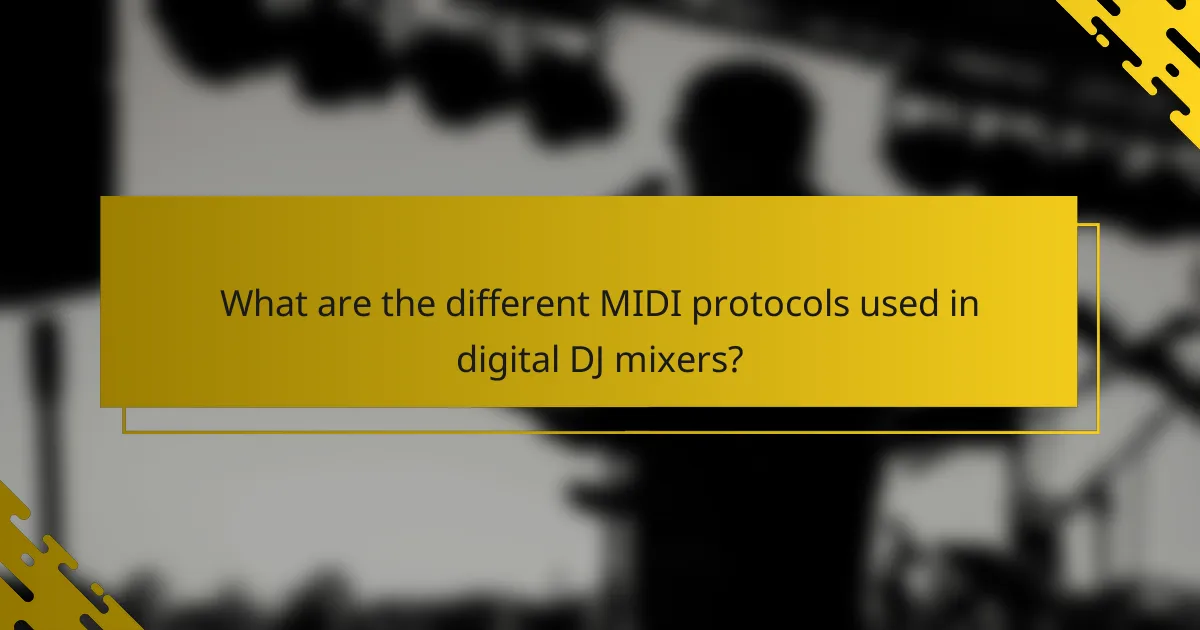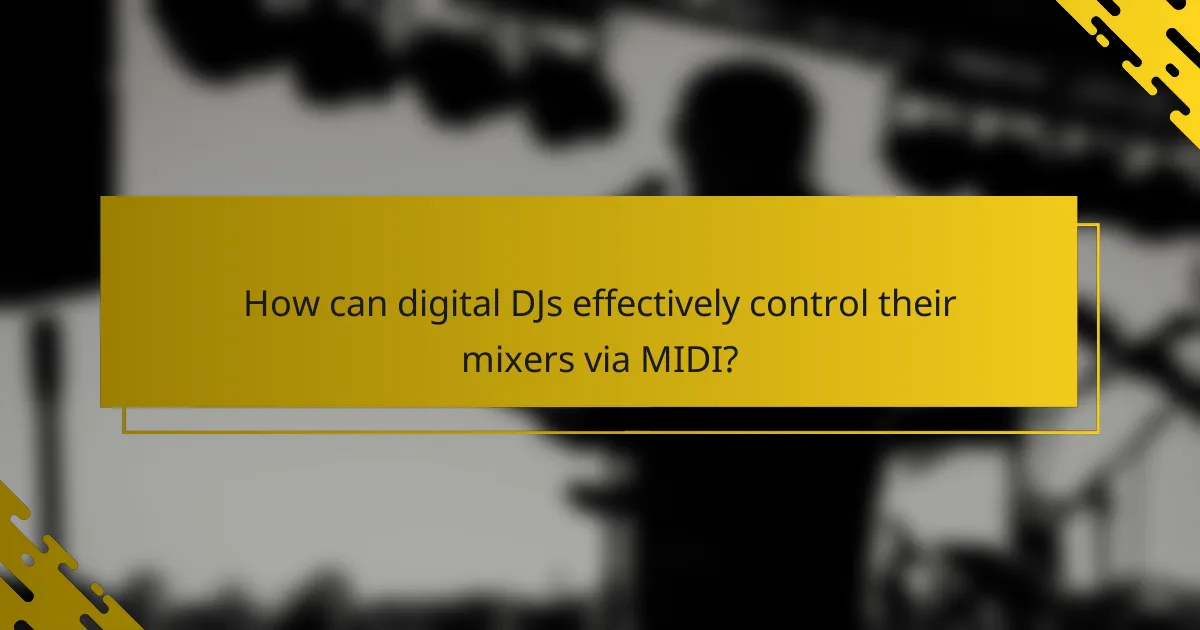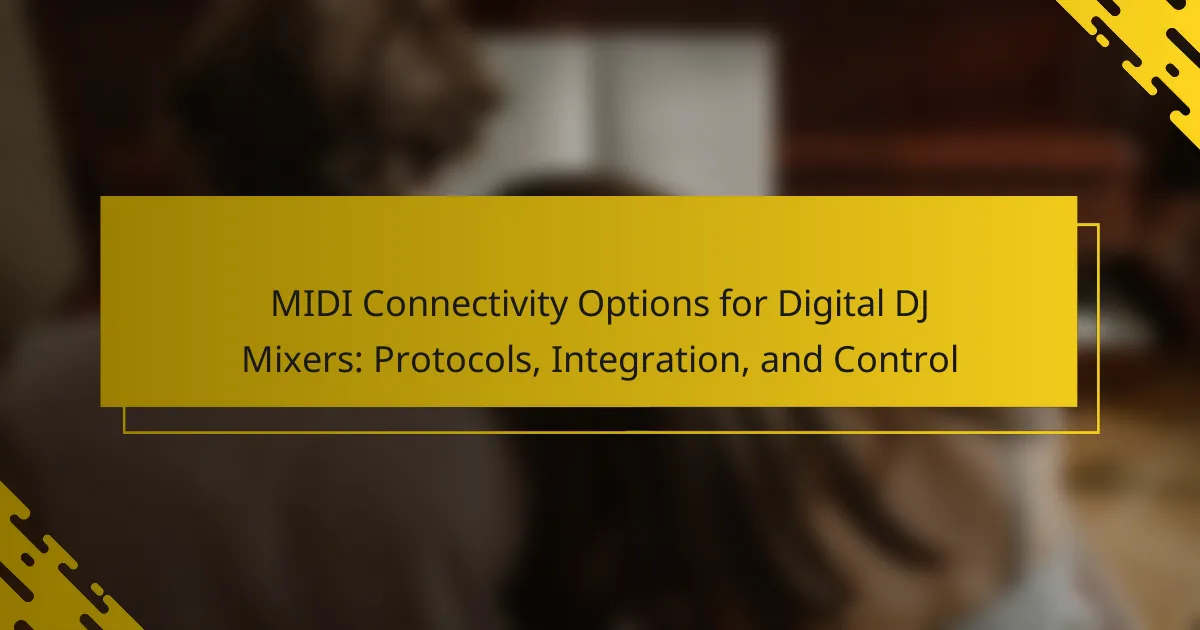Digital DJ mixers are essential tools for modern DJs, offering various MIDI connectivity options such as USB, DIN connectors, and MIDI over Ethernet. These connections facilitate seamless integration with digital audio workstations and other MIDI-compatible devices, enhancing performance flexibility. The article explores different MIDI protocols, including MIDI 1.0, MIDI Time Code (MTC), and MIDI Show Control (MSC), each serving specific functions to improve synchronization and control during performances. Additionally, it discusses how DJs can effectively use MIDI mapping to customize mixer controls, allowing real-time manipulation of volume, effects, and EQ settings, ultimately improving workflow efficiency and creative expression.

What are MIDI Connectivity Options for Digital DJ Mixers?
Digital DJ mixers typically offer several MIDI connectivity options. Common options include USB, DIN connectors, and MIDI over Ethernet. USB connections allow direct interfacing with computers and software. DIN connectors provide traditional MIDI connectivity to external devices. MIDI over Ethernet enables networked control and integration with other gear. Many mixers support MIDI clock synchronization for tempo alignment. These options facilitate seamless integration with digital audio workstations and other MIDI-compatible devices.
How does MIDI connectivity enhance digital DJ mixers?
MIDI connectivity enhances digital DJ mixers by enabling precise control over various functions. It allows DJs to synchronize multiple devices seamlessly. This synchronization improves performance consistency and creativity. MIDI also facilitates the mapping of controls to software parameters. This mapping provides a personalized workflow tailored to individual preferences. Additionally, MIDI enables the integration of external hardware like drum machines and synthesizers. This integration expands the sound palette available to DJs. Overall, MIDI connectivity significantly increases the versatility and functionality of digital DJ mixers.
What are the key components of MIDI connectivity in DJ setups?
The key components of MIDI connectivity in DJ setups include MIDI controllers, MIDI interfaces, and software applications. MIDI controllers send performance data to other devices. They can be keyboards, drum pads, or mixers. MIDI interfaces facilitate communication between MIDI devices and computers. They convert MIDI signals into a format that computers can understand. Software applications process MIDI data for music production and live performance. They allow DJs to manipulate sounds and effects in real-time. Together, these components enable seamless integration and control in DJ setups.
How do different MIDI protocols influence mixer performance?
Different MIDI protocols can significantly influence mixer performance by affecting communication speed, data resolution, and compatibility. For instance, MIDI 1.0 operates at a 31.25 kbps data rate, which limits the amount of information transmitted. This can lead to latency issues in performance, especially with complex setups. In contrast, MIDI 2.0 enhances this by allowing higher data rates and increased resolution, improving the accuracy of control messages. This results in more responsive and dynamic mixing capabilities. Furthermore, protocols like MIDI over USB offer greater flexibility in connecting multiple devices without the need for traditional MIDI cables. This facilitates easier integration with computers and DAWs, enhancing workflow efficiency. Overall, the choice of MIDI protocol directly impacts the effectiveness and responsiveness of digital DJ mixers.
Why is MIDI integration important for digital DJs?
MIDI integration is important for digital DJs because it allows for seamless control of multiple devices and software. This integration enhances performance by enabling DJs to manipulate sound and effects in real-time. MIDI technology connects various hardware and software, facilitating communication between them. Digital DJs can use MIDI controllers to trigger samples, loops, and effects without interrupting their mix. The ability to customize MIDI mappings allows for personalized setups tailored to individual preferences. Additionally, MIDI integration supports automation, which can streamline complex tasks during live performances. Overall, it significantly expands a DJ’s creative possibilities and enhances their live show.
What advantages does MIDI integration provide in live performances?
MIDI integration offers several advantages in live performances. It allows for precise control of multiple instruments and devices. Musicians can synchronize their gear seamlessly, enhancing overall performance cohesion. MIDI facilitates real-time manipulation of sound parameters, enabling dynamic changes during a set. This integration also supports complex arrangements without the need for extensive physical setups. Furthermore, MIDI can trigger samples and loops effortlessly, adding depth to live shows. The technology is widely compatible, making it easy to incorporate various devices. Overall, MIDI enhances creativity and efficiency in live music settings.
How does MIDI integration affect studio production workflows?
MIDI integration streamlines studio production workflows by enhancing communication between devices. It allows for the synchronization of multiple instruments and software. This synchronization leads to more cohesive music production. MIDI data can control various parameters in digital audio workstations (DAWs). For instance, it can automate volume levels, effects, and instrument sounds. This capability reduces the need for manual adjustments during mixing. Moreover, MIDI facilitates real-time performance adjustments, improving creativity. Overall, MIDI integration increases efficiency and flexibility in studio environments.

What are the different MIDI protocols used in digital DJ mixers?
The different MIDI protocols used in digital DJ mixers include MIDI 1.0, MIDI Time Code (MTC), and MIDI Show Control (MSC). MIDI 1.0 is the standard protocol for transmitting performance data. It enables communication between devices like mixers and controllers. MIDI Time Code synchronizes audio and video equipment. It ensures all devices operate in perfect timing. MIDI Show Control provides commands for show control systems. This protocol allows for control of lighting and effects during a performance. Each protocol serves specific functions in enhancing the DJ experience.
How does the MIDI 1.0 protocol function in DJ setups?
The MIDI 1.0 protocol functions in DJ setups by enabling communication between electronic musical instruments and devices. It transmits digital signals that represent musical performance data. This includes note information, control changes, and timing messages. DJ mixers equipped with MIDI can send and receive these signals to synchronize devices. For example, a MIDI controller can trigger samples or control effects on a DJ software. The protocol operates over a simple 5-pin DIN connector or USB. MIDI 1.0 allows for real-time interaction and performance flexibility. It standardizes connections, making integration of various devices seamless. This functionality enhances live mixing and performance capabilities in DJ setups.
What are the limitations of the MIDI 1.0 protocol?
The MIDI 1.0 protocol has several limitations. It supports a maximum of 16 channels, which restricts simultaneous control over multiple devices. The resolution for note velocity is limited to 128 levels, affecting dynamic expression. Additionally, MIDI 1.0 does not transmit audio data, only control messages. There is no support for polyphonic aftertouch, limiting expressive capabilities. The protocol lacks a standardized way to transmit timing information, which can affect synchronization. Lastly, it operates at a fixed baud rate of 31.25 kbps, limiting data transfer speed. These limitations can hinder performance in complex music production environments.
How does MIDI 2.0 improve upon its predecessor?
MIDI 2.0 improves upon its predecessor by significantly enhancing resolution and expressiveness. It offers 32 bits of resolution for parameters, compared to the 7 bits in MIDI 1.0. This allows for finer control over dynamics and nuances in performance. MIDI 2.0 also introduces a new capability called “per-note expression.” This feature enables individual notes within a chord to be controlled separately. Additionally, MIDI 2.0 supports higher data rates, allowing for faster communication between devices. The protocol also includes improved features for device discovery and configuration, streamlining setup processes. These enhancements collectively lead to a more versatile and responsive musical experience.
What are the advantages of using USB MIDI connections?
USB MIDI connections offer several advantages for digital DJ mixers. They provide a direct and simple interface for connecting devices. This connection eliminates the need for additional MIDI cables and converters. USB MIDI supports high-speed data transfer, ensuring low latency. It allows multiple devices to connect through a single USB hub. USB MIDI connections are also universally compatible with most operating systems. They enable easy integration with software applications for music production. Additionally, USB MIDI devices often receive power through the USB connection, reducing the need for external power sources.
How does USB MIDI enhance connectivity with other devices?
USB MIDI enhances connectivity with other devices by providing a standardized, efficient communication protocol. This protocol allows digital DJ mixers to connect seamlessly with computers, synthesizers, and other MIDI-compatible devices. USB MIDI supports multiple channels, enabling simultaneous communication with various instruments. It simplifies the setup process by requiring only a single USB cable for data transfer and power. Additionally, USB MIDI is widely supported across platforms, ensuring compatibility with different operating systems. This broad compatibility facilitates integration into diverse audio setups. The speed of USB MIDI ensures low latency, which is crucial for live performances. Overall, USB MIDI streamlines the workflow for DJs and musicians, enhancing their creative possibilities.
What are the common challenges faced with USB MIDI connections?
Common challenges faced with USB MIDI connections include latency issues, compatibility problems, and power supply requirements. Latency can cause a delay between input and output, affecting performance. Compatibility issues arise when devices use different MIDI versions or drivers. Some USB MIDI devices may require external power sources, complicating setup. Additionally, cable quality can impact signal integrity. These factors can hinder seamless integration in digital DJ setups.

How can digital DJs effectively control their mixers via MIDI?
Digital DJs can effectively control their mixers via MIDI by mapping MIDI controls to specific mixer functions. This allows DJs to manipulate volume, effects, and EQ settings in real-time. MIDI mapping can be done using software like Ableton Live or Serato DJ. DJs connect their mixers to a computer via USB or MIDI cables. The software recognizes the mixer and enables customization of controls. MIDI messages sent from the DJ’s controller trigger corresponding actions on the mixer. This integration enhances performance flexibility and responsiveness. Studies show that MIDI integration improves workflow efficiency for DJs, allowing for seamless transitions and creative expression during sets.
What are the best practices for mapping MIDI controls?
The best practices for mapping MIDI controls include establishing a clear layout for controls. This layout should prioritize the most frequently used functions. Assign MIDI channels logically to avoid conflicts. Use consistent naming conventions for ease of identification. Document the mapping process to maintain clarity. Regularly test the mappings to ensure functionality. Update mappings based on user feedback for improvement. These practices enhance workflow efficiency and ensure a seamless user experience.
How can DJs customize MIDI mappings for specific software?
DJs can customize MIDI mappings for specific software by accessing the MIDI settings within the software interface. Most DJ software allows users to create or modify MIDI mappings. This is typically done through a dedicated MIDI mapping section in the settings menu. DJs can assign specific functions to MIDI controller buttons, knobs, and faders. They can also adjust parameters such as sensitivity and response curves. Many software programs offer templates for popular controllers, simplifying the mapping process. Additionally, users can save custom mappings for future use. This flexibility enables DJs to tailor their setups to suit their performance style.
What tools are available for MIDI mapping in DJ software?
MIDI mapping tools in DJ software include dedicated mapping features, MIDI learn functions, and third-party mapping applications. Popular DJ software like Serato DJ, Traktor Pro, and Ableton Live provide built-in MIDI mapping capabilities. These tools allow users to assign MIDI controls to various software functions seamlessly. MIDI learn functions enable automatic detection of MIDI signals from controllers. Third-party applications like Bome MIDI Translator and MIDI-OX offer advanced mapping options. These tools enhance customization and control for DJs.
What troubleshooting tips should DJs consider for MIDI connectivity issues?
Check all MIDI cables for damage or loose connections. Ensure MIDI devices are powered on. Verify that the correct MIDI channel is selected on both devices. Test the MIDI connection with different cables to rule out faulty ones. Update the MIDI device firmware if available. Restart all devices to reset the connection. Use MIDI monitoring software to check signal transmission. Consult the user manual for specific troubleshooting steps related to your devices.
How can common MIDI connectivity problems be resolved?
Common MIDI connectivity problems can be resolved by checking cable connections, ensuring proper driver installation, and verifying MIDI settings. First, inspect all MIDI cables for damage and ensure they are securely connected. Next, confirm that the correct drivers for your MIDI device are installed and updated on your computer. Additionally, check the MIDI settings in your software to ensure the MIDI device is recognized and configured properly. This includes selecting the right input and output ports. Restarting both the MIDI device and the computer can also help reset connections. If issues persist, testing the MIDI device with different software can identify if the problem lies within the application.
What maintenance practices can prevent MIDI issues in the future?
Regularly updating MIDI software and firmware can prevent MIDI issues in the future. Keeping software current ensures compatibility with new features and fixes bugs. Regularly inspecting and cleaning MIDI cables helps maintain signal integrity. Damaged or dirty cables can lead to connectivity problems. Additionally, checking device settings for proper configuration can prevent miscommunication between devices. Performing routine tests of MIDI connections can identify issues early. Using quality cables and connectors reduces the risk of hardware failures. Following these practices helps maintain reliable MIDI performance over time.
MIDI connectivity options for digital DJ mixers are essential for enhancing performance and integrating various devices. The article covers the different protocols, including MIDI 1.0 and MIDI 2.0, and their impact on mixer performance, as well as the advantages of USB MIDI connections. It explores how MIDI integration improves live performances and studio production workflows, highlighting key components and best practices for effective control and mapping. Additionally, the article addresses common challenges and troubleshooting tips to ensure reliable MIDI functionality in DJ setups.
